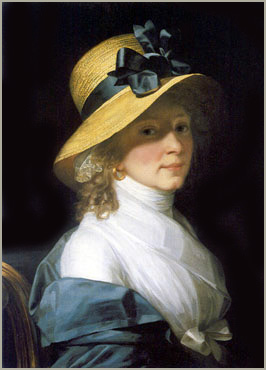Portrait of a Lady
The portrait of Elisabeth Hudtwalcker, born Moller, also known as “Die Schöne Hamburgerin – The Beatiful Lady Of Hamburg”, was painted in 1798 in Hamburg by Jean Laurent Mosnier (1743-1808). The original is in the collection of Hamburger Kunsthalle, Hamburg, Germany.

Mosnier was born in Paris, France, and received his education at the Parisian Academy St. Luc. In 1766 he was appointed Court painter by the Queen of France, Marie-Antoinette, and in 1788 he became a member of the Royal Academy. At the outburst of the French revolution in 1789 he fled to London where he stayed for approximately six years (while his former employer, the Queen, was executed). In 1796 Mosnier arrived in Hamburg, Germany, however, in 1802 he got a new prestigious calling by being appointed Court painter once more, now by the Russian Czarina Elisabeth Alexejewna, and Mosnier moved to St. Peterburg. Reflecting his geographical movements, his paintings are in the collections of the Louvre. the Erimitage and Hamburger Kunsthalle.
Elisabeth Hudtwalcker (1752 – 1804) was married to Johann Michael Hudtwalcker (1747 – 1818), a businessman and Senator of Hamburg. They enjoyed a happy marriage. Johann Michael gave her the nickname “Betchen”, and admired his talented wife. In his notes to her biography he wrote that she was “a genius” and had “the grace of a Goddess”.
She learned Latin, English and French, and could quote whole passages of Racine’s work by heart. She danced the menuet and did her own drawings from early childhood on. Later in life she took lessons in pastel; – and oilpainting, and made miniature portraits of her aunts, uncles and cousins. After the wedding she did portraits of her husband and parents in law. Together the couple had five children. All of them got their portrait done by their mother. Elisabeth and Johann Michael Hudtwalcker held a great, and welcoming, house, visited by many prominent guests. The summers were spent in a small garden by Deichtor, Hamburg, designed for them by the architect Johann August Arens, who was put in charge of laying out their second, and bigger, garden at Eppendorf.
Although Elisabeth Hudtwalcker would have liked to become a painter, she felt she “had higher obligations”, as her husband writes in the biography. Between her duties as wife, mother, hostess and responsible for the great household, she was nevertheless encouraged to paint by such famous painters as Chodowiecki, Tischbein (1750 – 1812) and Schadow. Daniel Chodowiecki (1726 – 1801) was a frequent houseguest at the Hudtwalcker home, and praised her works, and the sculptor and painter Johann Gottfried Schadow (1764 – 1850) advised her to draw with a silverpin, a tool he used himself.
Elisabeth Hudtwalcker was a devoted reader of literature. One of her favourites were the early odes of her uncle, Friedrich G. Klopstock, but she also had a keen eye for the more spiritual, yet ironical aphorisms of the author Georg Christoph Lichtenberg. She studied the theories of physiognomy of the Swiss writer and pastor, Johann Kaspar Lavater (1741 – 1801), another frequent guest in the Hudtwalcker house. Lavater tried to see the detail, the particular, as a part of a divine world order. Johann Heinrich Wilhelm Tischbein, known for his portraits of Goethe, was the last guest to visit Elisabeth Hudtwalcker ten days before her death.
Portraits and biographies describes Elisabeth Hudtwalcker as an open and intelligent woman, elegant and humorous, but with a deep, and sincere, cultural interest, having a special warm heart for the painters of her time, of whom many where her colleagues and friends. Regarding the visit to their home by Jean Laurent Mosniers, Johann Michael Hudtwalcker comments:
“Mosnier came here, he painted her, and she thanked this great artist for whom she held the highest esteem. She became full of life during their vivid conversations which could last long into the evenings.”
Written by: Katharina Baark in the newspaper “Hamburger Abendblatt” on September 14, 1987.
Translated from German, and modified, by John Michael Hudtwalcker, Oslo, Norway, January 2005.
www.hudtwalcker.com 2014
